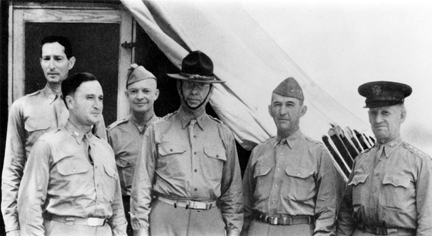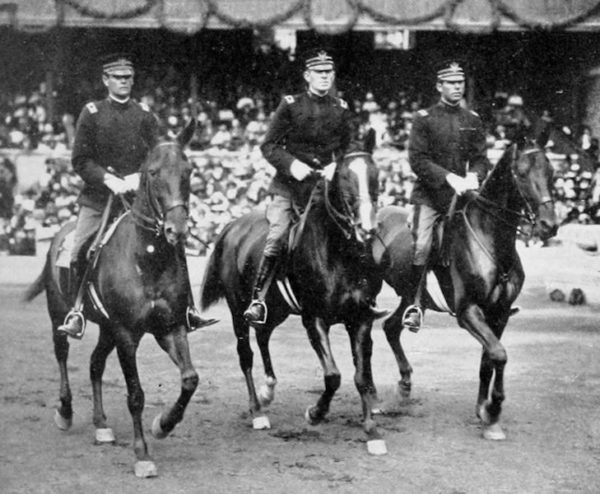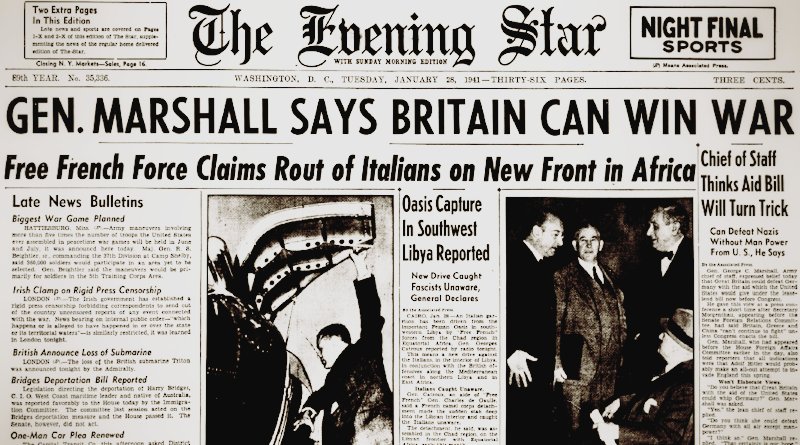World War II Chronicle: January 28, 1941
Click here for TODAY’S NEWSPAPER
Pictured on today’s front page: Under Secretary for War Robert P. Patterson inspects a Lockheed YP-38 Lightning. The Air Corps ordered 13 of the cutting-edge pursuit planes and the last plane will reach the military in June. Patterson earned the Distinguished Service Cross in France in 1918, leading a three-man reconnaissance patrol that destroyed one outpost and inflicted numerous casualties on another. Capt. Patterson covered his men’s retreat and had to play possum until dark, allowing him to crawl away from the enemy…
The paper quotes Maj. Gen. Robert S. Beightler Sr., commanding officer of the 37th Infantry Division, as saying the military plans to conduct the largest peacetime training in U.S. history: the Louisiana Maneuvers.
When Germany invaded Poland in 1939, the United States Army was a relatively tiny peacetime force. 16 million men signed up for the draft in the fall of 1940, and by January the Army had swelled to 630,000 soldiers (13 divisions). By June, that number grew to 36 divisions and 1.4 million troops. Gen. Beightler may have been blooded (worked his way from private to first sergeant before earning a commission in 1913, then fought in World War I), but the vast majority of the force was green and needed experience before they were thrown into the crucible of combat.

Looking at the photo of the officers above: Mark Clark was a major a year ago and is on the fast track to become the U.S. Army’s youngest two-star general. He pinned on his brigadier general star — completely bypassing the rank of colonel — before working with Gen. McNair to select the site of the Louisiana Maneuvers. Dwight D. Eisenhower currently commands 1st Battalion, 15th Infantry Regiment at Fort Lewis (Wash.), but is about to move up himself.
We will explore the Louisiana Maneuvers more in coming months, but it is worth noting now that the Army learned valuable lessons from the war games, saving countless lives on the battlefield. One thing the Army discovered was which commanders were effective peacetime leaders but couldn’t cut it under fire. Gen. George Marshall replaced dozens of commanders following the Louisiana Maneuvers.
Gen. Beightler kept his command; In fact, he was one of the few National Guard commanders to lead their troops throughout the entire war. Another officer that survived the purge was Second Army’s Lt. Gen. Benjamin Lear. Lear was also a mustang officer, serving as the 1st Regiment of Colorado Volunteers’ first sergeant during the Spanish-American War, then as a commissioned officer during the Philippine-American War and World War I.
During a golf outing in Memphis, Tenn. in July, Lear witnessed 35th Division soldiers cat-calling women from their convoy. Unaware that Lear, who was wearing civilian clothes, commanded their Army, the soldiers also jeered at Lear, who halted the convoy and ordered the soldiers to finish the 15-mile trip to Camp Robinson in Arkansas on foot. Several soldiers passed out from the 97-degree heat, infuriating the 35th Division’s CO, Maj. Gen. Ralph E. Truman (cousin of then-senator Harry S. Truman, who was also assigned to the 35th Division). Gen. Truman tried to use the incident to force Lear into retirement, but that fall it was in fact Lear who axed Truman — following the Louisiana Maneuvers.

Above are three members of the U.S. Cavalry team that earned the Bronze Medal in the equestrian team event of the 1912 Olympics. We mentioned Lear, who is on the right. On the left is Capt. Guy V. Henry Jr., son of Gen. Guy V. Henry Sr., who earned the Medal of Honor during the Civil War as a Union cavalry commander and was decorated for valor in the Indian campaigns and the Spanish-American War. Like his father, Guy Jr. also graduated from the U.S. Military Academy (Classes of ’61 and ’99 respectively), served as a cavalry officer, commanded Fort Meyer, Va., and became a general himself after service in multiple wars.
John C. Montgomery (center) was commissioned in the cavalry after graduating from West Point (Class of ’03). He married Virginia Lee, daughter of Gen. Fitzhugh Lee, commander of the Confederate Cavalry Corps following the death of J.E.B. Stuart, and Robert E. Lee’s nephew. During World War I, Lt. Col. Montgomery’s battlefield performance was so exemplary that Gen. John J. Pershing, who personally witnessed the events, promoted him to colonel — the only spot promotion granted by Pershing during the war. After the Armistice, Montgomery was made Chief of Staff of the American Forces in Germany.
It’s interesting to look at the photo above and think that Henry’s father and Montgomery’s father-in-law fought each other, but the sons served together. And having mentioned West Point, Gen. Beightler’s son, Robert S. Beightler Jr. will graduate from the USMA in 1943 fighting in the New Guinea and Philippine Campaigns and participating in two combat jumps. The younger Beightler was an captain in the 511th Parachute Infantry Regiment, eventually reuniting with his father on Luzon Island.
Evening star. (Washington, D.C.), 28 Jan. 1941. Chronicling America: Historic American Newspapers. Lib. of Congress.
https://chroniclingamerica.loc.gov/lccn/sn83045462/1941-01-28/ed-1/
